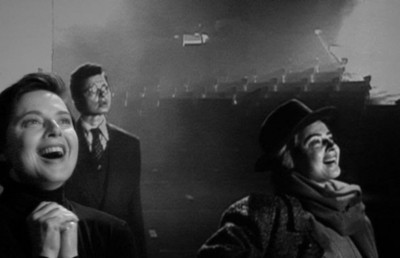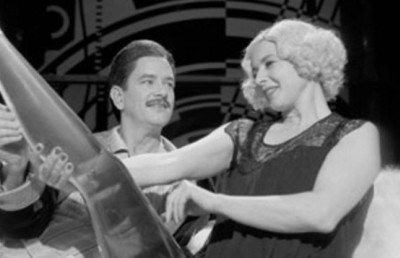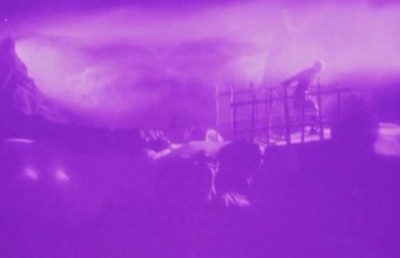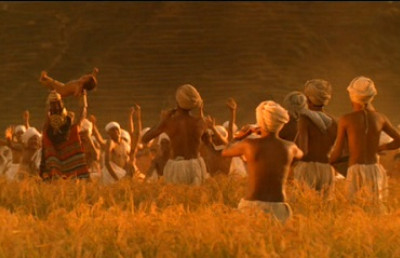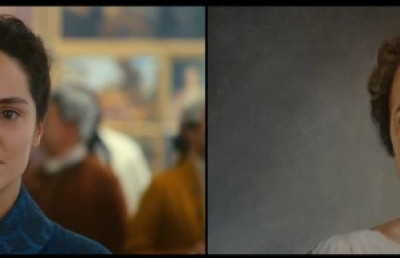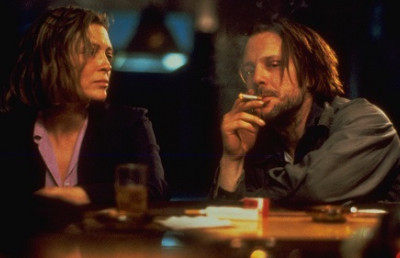Music, comedy and class: The Immigrant and Gold Diggers of 1933
Comedy and Social Meaning
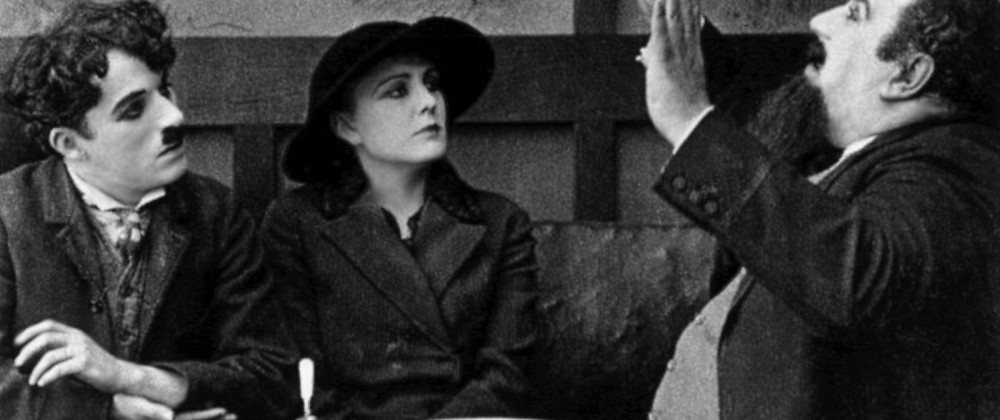
One of the key themes in Charlie Chaplin’s The Immigrant (1917) is that of the possibility of poverty leading to the loss of identity. This notion is introduced just before the immigrants leave the boat as they are kept behind a rope and given identity tags that ironically make them all appear the same, like livestock. Charlie’s hat is a symbol of his identity, both as an individual (we have seen him wear this in other films) and as an Englishman:
I thought of all the little Englishmen I had seen with small black moustaches, tight-fitting clothes, and bamboo canes, and I decided to model my make-up after these men (Chaplin, p.50).
While the bowler hat is specifically English, the different hats of the other people on the boat all suggest their different National identities. As Charlie is forced to take his hat off at the restaurant there is the threat that he may have his identity taken from him, initially reinforced by the fact that the upper class man sitting next to Charlie looks similar to him. As this man gradually shows himself to be unlikeable, fussing about Charlie’s eating habits, and leaves the table, this threat becomes diminished. The threat returns, however, as a man is beaten up for not having enough money to pay for his meal and is kicked out, losing his top hat in the scuffle, so that the permanent loss of identity is threatened as the result of poverty.
In this film the themes of class inequality and ethnic inequality become inter-related and working-class solidarity becomes at one with solidarity between ethnic minorities. This can be seen in the relationship between Charlie and Edna, both of whom are poor and of ethnic minorities. When they meet in the restaurant we are not given any inter-titles –as they would be unnecessary– since it is plain to see that they are in love. This apparently universal connection between them is extended by Chaplin’s recognition of the meaning of Edna’s handkerchief: that her mother has died. When sound later became possible Chaplin claimed that sound film was limited, as the universality of silent film had been lost: “The silent picture, first of all, is a universal means of expression. Talking pictures … are held down to the particular tongue of particular races” (Chaplin, p. 63). As Chaplin extends this notion by saying that “Primitive folk used sign language before they were able to form an intelligible word,” he seems to be getting at a notion that film images may be able to form a liminal space that goes beyond language itself. Chaplin seems to some degree to pre-empt Christian Metz’s essay ‘Identification, Mirror’ that builds on Lacan’s notion of the ‘Mirror Phase.’ Lacan has argued that ego-formation comes about through identification with an image or images and that in our lives all images can, on some level, have the effect of ‘capturing’ their audience by offering a reversion to the moment at which their ego was formed. Metz has extended this notion to suggest that images on a film screen can equally have this effect. In this sense if the scene between Charlie and Edna had an inter-title, their love would be explained away by language; as it does not, they form a universal bond through the images. This bond allows us to see that people of both the working classes and different ethnic minorities are exposed to the same threat: that their possibility of an individual identity, separate from American society as a whole, may be taken from them.
While Chaplin recognises the great possibility of silent film to offer a feeling of universality beyond language, he also recognises the limitations of the medium and uses them when characters attempt to challenge Charlie and Edna’s sense of their own individual identities. We see this when both the audience and Chaplin cannot understand what the waiter is saying when he first tells Charlie to take his hat off, thus the lack of sound formally suggests the fact that American society’s ideological conformism is unable to relate to a different ethnic type. Here the American custom of not wearing a hat in a restaurant is seen not to be universal, as the English Charlie is not familiar with it. The ‘artist’ is likewise trying to express a supposedly universal image of the immigrants, yet this is undercut as his lengthy talk is given only the inter-title of, “I am an artist.” This allows us to see that while the man speaks a lot, he is only really interested in his own ‘art’ and that this ‘art’ will not understand them, and therefore present them as a clichéd image of the ‘desolate poor.’ The inter-title here has the effect of rejecting what is said by the artist, whose real speech we will never know, as the film is silent. The absence of sound is thus used to confine the artist, just as he would have confined the immigrants into his own artistic scheme.
André Bazin has noted that Chaplin offers a, “total indifference to the category of things held sacred” (Bazin, p. 152). In doing this he mocks the, “thousand forms of acceptable behaviour which are a sort of permanent liturgy that [society] performs in its own honour” (Bazin, p. 153). Bazin here is commenting on the Charlie character himself, who “never really manages to master the use of his knife and fork” and thus shows up mainstream society’s obsessions with etiquette. We can extend this idea, however, to Chaplin’s own formal film practise. Chaplin gets in the way of the claims to universality of mainstream American society by not allowing it to be ‘heard,’ yet maintains an apparently universal love between the outsiders, through our not needing them to be ‘heard.’ As such he aligns the silence and the emphasis on images over language with an apparently universal subversiveness (accepting the individuality of working class people and ethnic minorities) that is specifically against the claim of universality of conformist American society.
The artist’s romantic image of the poor as helpless (for example, he assumes Charlie will not be able to pay for his meal and offers to pay instead) is also mocked by the fact that Charlie proves himself capable of overcoming his poverty by way of wit. Charlie achieves this by cleverly using the artist’s tip to pay for their meal, without the artist knowing, and even manages to get two more dollars out of the artist. As Charlie gets his hat back (in the sense that he wears it once out of the restaurant) he shows that he has overcome two threats of the loss of identity: the first of poverty taking it from him and the second of his being ‘pictured’ as desperately poor and so in need of charity. Chaplin uses comedy throughout the film, including the classic comedy ending of marriage, to counter the image offered by the ‘artist’ in the film, and artists in general, of the poor being unable to take care of themselves. Charlie does not attain this money through luck: the coin he finds on the street, loses and gets back again turns out to be fake, showing us that the streets are not paved with gold. Instead Charlie makes money through his trickery of the gamblers on the boat and as we have seen through his trickery of the ‘artist.’ As such Charlie to some degree adheres to the notion of ‘upward mobility,’ the sense that anybody can make their way in society, either through education or enterprise. Since Charlie seems as if he will do well for himself, the film allows for a reading where it is possible for all people to do well in society through their own means. Chaplin, an immigrant himself, depicts immigrants in this fashion because he wants to make them likeable for a popular audience.
One criticism of the film, however, could be that it is not as easy as the film depicts for immigrants to get money in the real world. In some ways the film allows for a conservative or reactionary reading, which states that if society helped the working classes and immigrants economically, they may in turn become lazy, not bother to look for work, and become potentially non-productive members of society. I doubt that Chaplin himself would believe this to be the case; especially considering the satirical scene of the man thrown out of the restaurant for being only ten cents short on his food bill. Clearly Chaplin recognises that society can take the notion of ‘everyone paying their own way’ to extremes. Likewise Charlie gives his money to Edna not simply for love but because her elderly mother has lost her money; he seems to recognise that she needs the money more than he does. If Chaplin’s film had the effect of downplaying the poverty of immigrants it was not due to the intentions of the artist but simply to the suggestion of the possibility of ‘upward mobility,’ and to the form he uses. To close the film on a comic note with no specific reference to poverty, Chaplin allows his audience to momentarily ‘escape’ the poverty of his characters by way of the happy ending –with Charlie and Edna about to be married– and lay open the possibility that this may also be the case in real life.
Unlike the combination of individualism and collectivism in The Immigrant, Mervyn Le Roy and Busby Berkeley’s Gold Diggers of 1933 (1933) is an overtly collectivist film in which the effects of the Great Depression caused by the Wall Street Crash of 1929, mass unemployment and poverty, are represented. The depiction of poverty in itself would have felt liberating for the poor, who had been fed lies from officials –politicians, bankers, journalists– that the Depression was not so great and the economy was on the upturn. By 1933, these lies had become recognised as false. For example, in that year Gilbert Seldes articulated the frustration these lies had caused ordinary Americans: “We were not permitted for many months to confront the reality of the situation” (Seldes, p. 25). The breaking apart of the introduction song to Gold Diggers, ‘We’re in the Money,’ due to insufficient funds allows us to see the delusional nature of this view of society at the time. Gold Diggers of 1933 can be understood as a self-reflexive musical, showing the process by which the film itself, like the stage performance, is an illusion, not for a Brechtian effect but, on the contrary, to reaffirm the importance of the illusion and necessity of entertainment. Jane Feuer uses the term ‘myth of integration’ to refer to the way that, as musical numbers become integrated into the film we are given the sense that, “all successful performances, both in art and in life, are condensed into the MGM musical” (Feuer, p. 443). This is also achieved in relation to class issues in Gold Diggers of 1933 as high society, represented through the upper-class characters, is shown at first to be separate from popular society, yet by the end of the film becomes integrated into that society. This integration occurs when each of the upper-class men marries one of the showgirls. The integration of high society at a general level can be seen, perhaps in a half-mocking tone, in the scene where the showgirls play violins, which refers back to and dismisses Brad Roberts’ (Dick Powell) rejection of the ‘Boston Symphony Orchestra’ as half-dead. The purpose of this integration is to argue that the upper classes would not be morally justified in separating themselves from the working classes, either emotionally or economically.
The film recognises a class divide in society and attempts to counter critical reactions, from either the working classes or upper classes, to the integration of the upper classes into what would have been considered a working class ‘issue’: poverty. People of the upper classes would have felt that they were simply being swindled for money, while those of the working classes would have felt offended at an upper class person writing the songs for a show about poverty. The film attempts to achieve this countering of criticism by not telling us that Brad is upper class until about halfway through, by which time the audience will have already warmed to the bonds between Brad and Polly Parker (Ruby Keeler), as well as those between Brad and Barney Hopkins (Ned Sparks). The first song encourages his working class audience to engage with him emotionally, before they discover that he is upper class, through the ‘universal’ notion of love –that between him and Polly– as he sings, “let me live my song.” Brad’s second song alternatively encourages an upper class audience to recognise that they have to engage in the gritty ‘reality’ posed to them by the working classes through the Depression era. This can be seen again expressed through the ‘universal’ notion of love, as he has “to sing a torch song to someone far apart.” The fact that “it must be real” emphasises the theme of a universal ‘reality’ of the Depression; and to the upper classes the struggles of the Depression would certainly have seemed “far apart.” Performed before we discover Brad’s upper class origin, these songs will appear to the audience to be only about love, and so the class collectivism imbedded in their lyrics is intended to have a primarily unconscious influence on the audience.
The fact that the messages of the songs can be related to both a ‘universal’ love between the classes and the ‘reality’ of the economic problems suffered by the working classes in the Depression era, suggests that these cannot be separated. The money Trixy (Aline MacMahon) gets out of Mr. Peabody (Guy Kibbee) can symbolically serve as suggesting on some level that the working classes have a right to economic help from the upper classes. As this is the first time Mr. Peabody has been in love, we are shown that this could be as much a benefit for the upper classes –to engage with ‘real’ love/life– rather than just with cold economics. As such Gold Diggers of 1933 differs from The Immigrant in that while both recognise that a class-divide exists, The Immigrant emphasises this divide, sides with the working classes, and essentially rejects the need for money from the upper classes. Gold Diggers of 1933 on the other hand makes itself appear not to be taking sides, suggesting that the class divide is not as great as it appears and also suggesting a connection between the classes to include the upper classes in its own collectivism. The intention is to convince members of both classes that the upper classes are obligated to help the lower classes out of the Great Depression.
The notion of an engagement with ‘reality’ (of course a constructed social reality) becomes perhaps the key theme of the film in the final song ‘Remember My Forgotten Man.’ Berkeley’s choreography for the song connects images of men on breadlines with images of soldiers going in and out of war. This connection suggests a conscious siding with the ‘Bonus Army,’ the war veterans who squatted in Washington D.C. for money and/or jobs and were routed out with tear gas by the Hoover administration (Rubin, p. 73). The message of the song is clear: the working classes fought alongside the upper classes in a war for the country, for the sake of all classes, and it is the country’s duty to repay this debt by joining together and helping the working classes out of the Depression. The self-reflexive style, we see for example the treadmills that ensure the soldiers stay on stage for longer while walking, aligns the reality of the performance itself with the ‘reality’ of the Great Depression. As such the mythologising and ‘universalising’ nature of the musical is intended to make this claim to a universal social ‘reality’ convincing for an audience that enjoys musicals. This ‘reality’ is of course itself a myth created to make us believe in the importance of dealing with the economic slump. The idea of the film is that the musical becomes more than just a musical, but an apparent ‘real life,’ so that as Brad takes the onstage role of courting Polly, he represents a utopian vision in which the upper classes emotionally relate with the lower classes. While the narrative itself ends on a hopelessly unachievable goal, the final number closes instead with the plea to ‘Remember My Forgotten Man.’
This song itself has a strange effect as it utilises this conformist vision to show us that the utopia has not been reached. While Carol King (Joan Blondell) is literally a performer, the ‘reality’ illusion that is created shows her as a prostitute of some sort, moving from a doorway to a lamppost and back to the doorway, with no particular purpose. While musicals mostly relate only back on themselves, Gold Diggers of 1933 situates this ‘reality’ effect in actual events the audience will have heard about in the media, for example the reference to the ‘Bonus Army,’ so links its own image of ‘reality’ with the world outside the musical.
The genres of both comedy and musical can have the effect of claiming a ‘universal’ vision of society. While Mervyn LeRoy and Busby Berkeley’s Gold Diggers of 1933 uses this effect to promote a socialist collectivism, Chaplin’s The Immigrant uses it for a very different purpose. Chaplin’s ‘universalism’ is one of the individual and the marriage at the end of the film can be seen as a collectivism of two people, both immigrants and working class, against the collectivism of American society. In The Immigrant Chaplin counters both the notion that the working classes and immigrants should conform to a ‘general’ American society, and that they will be incapable of taking care of themselves, and so a burden to society. Charlie is a self-sufficient character and as such shows American society that the working classes in general should not be treated as livestock –as are the immigrants on the boat. Overall, however, in the task of bringing issues of class division and inequality in America to light, Gold Diggers of 1933 is the more technically effective film. Gold Diggers of 1933 uses its own form to encourage members of the working and upper classes to consider their relation with the opposite class, while not pretending that this will be easy. It should be remembered that while the film ends in a song, the title is itself a contradiction in terms, with the effect of making us realise that the musical’s collectivism has not entirely extended out into the real world; and that it is the work of the audience to, ‘Remember My Forgotten Man.’
Bibliography
Bazin, Andre, in Hugh Gray (Ed.) What is Cinema? – Volume I, University of California Press: London, 1984.
Chaplin, Charlie, in Donald W. McCaffrey (Ed.), Focus on Chaplin, Prentice Hall: London, 1971.
Cook, Pam (Ed.), The Cinema Book, BFI: London, 1985, repr. 1990.
Doherty, Thomas, ‘Breadlines and Box Office Lines’, in Pre-Code Hollywood, Columbia University Press: New York, 1999.
Feuer, Jane, ‘The Self-Reflexive Musical and the Myth of Entertainment’, in Film Genre Reader II, Barry Grant Keith (Ed.), University of Texas Press: Texas, 1995
Rubin, Martin, ‘The Crowd, the Collective and the Chorus’, in Movies and Mass Culture, John Belton (Ed.), Rutgers University Press: New York, 1995.


